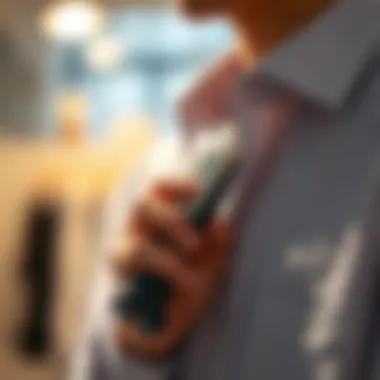Understanding Fabric Shavers and Lint Removers


Intro
Taking proper care of one’s clothing can often feel like a juggling act, especially in an age where fast fashion is the norm. Yet, maintaining garments is crucial not only for appearance but also for sustainability. This is where fabric shavers and lint removers enter the scene. These two devices often get overlooked, yet they play a pivotal role in the fabric care routine.
Understanding how to use these tools effectively can mean the difference between a well-maintained piece of clothing and a wardrobe filled with pilled, unattractive outfits. This article will navigate through the essential information on these handy devices: their functions, types, best practices for use, and maintenance tips that help not just in the short term but also in the long haul. We’ll explore how these tools not only revive the aesthetics of clothing but also empower an eco-conscious approach to fashion choices.
By emphasizing the best practices and knowledge surrounding fabric care, readers will feel more equipped to make smarter choices about how to prolong the life of their beloved garments, contributing to a more sustainable fashion culture.
Understanding Fabric Shavers
Fabric shavers are essential tools in the fabric care arsenal. Without a doubt, they can make a significant difference in how garments look and last. These devices serve a vital purpose in maintaining the aesthetics of clothing by eliminating unsightly fuzz and pills that can develop over time. Though it may seem trivial, this maintenance contributes to the overall longevity and appeal of fabrics, extending their life well beyond what would typically be expected.
Definition and Purpose
At its core, a fabric shaver is designed to remove lint, fuzz, and pilling from fabric surfaces. It operates through a series of sharp blades or rotating elements that carefully cut off the unwanted fibers without damaging the underlying material. The purpose here goes beyond mere appearances; it helps refresh tired garments, making them look newer and more polished.
Operational Mechanism
Understanding how fabric shavers operate can help users appreciate their benefits fully. Most fabric shavers utilize a rotating blade mechanism, where the blades shred the protruding fibers while allowing the remaining fabric to stay intact. This cutting action is usually controlled by a guard that protects the fabric underneath. This operational design maximizes efficiency while minimizing potential harm to the garment.
Types of Fabric Shavers
There are several kinds of fabric shavers, each catering to specific preferences and needs.
Manual Fabric Shavers
Manual fabric shavers are classic tools that require the user to apply physical effort. They typically come with a handle and a blade attached, allowing the user to glide it over the fabric. This makes them beneficial for quick touch-ups and for individuals who prefer hands-on tools. However, they can be physically demanding and may not be suitable for larger jobs.
Electric Fabric Shavers
Electric models are the bee's knees for those who frequently deal with a lot of lint and pilling. They have a motorized component that does the work with just the push of a button. This efficiency is their main appeal, saving time and effort. Still, some users may find them a bit cumbersome, as they rely on batteries or an outlet for power.
Battery-Powered Models
Battery-powered shavers bridge the gap between manual and electric options. They're gaining traction due to their portability, allowing users to maintain their garments on the go. They offer the convenience of electric shavers without the hassle of cords. However, the downside is that battery life can limit usage, making it crucial to keep spare batteries handy.
Key Features to Consider
When selecting a fabric shaver, several features can influence the decision-making process.
Blade Quality
The effectiveness of a fabric shaver largely depends on its blade quality. High-quality blades are less prone to dulling over time, ensuring efficient operation. A sharp blade can tackle lint and pilling efficiently without snagging the fabric.
Weight and Portability


For many, the weight of the fabric shaver plays a role; a lightweight device is easier to handle, particularly for extended use. Portability also becomes vital for those on the go, as compact models fit easily into bags or luggage.
Design Ergonomics
The design of a fabric shaver should consider comfort during use. Ergonomic grips allow users to maintain a steady hand without grappling with fatigue during longer sessions. Look for models that have user-friendly designs that comply with the natural contour of your hand.
In summary, understanding fabric shavers is crucial for effective clothing maintenance, helping users select the right tool based on their individual needs and fabric care practices.
By gaining insights into the definition, operation, types, and core features of these devices, one can formulate a strategy for garment care that complements their personal style and quality of clothing.
Exploring Lint Removers
Lint removers play a vital role in maintaining the overall aesthetics and longevity of fabrics. In the realm of clothing care, these tools serve as unsung heroes, ensuring that garments remain looking fresh and new. Lint, fuzz, and pet hair can easily mar the appearance of clothing, transforming even the most expensive fabrics into something that seems worn-out or neglected. Therefore, understanding the functions and options available in lint removers can make a significant difference in garment maintenance.
Definition and Usage
A lint remover is a device designed to eliminate lint, fuzz, and other small particles that cling to fabrics, making clothing appear untidy. These tools come in various forms, from handheld devices to simple stickyrollers. The primary purpose is similar across the board—to restore the garment's original look. Whether you're gearing up for a professional meeting or a casual outing, using a lint remover can give your clothing that sharp, well-groomed finish.
Differences Between Lint Removers and Fabric Shavers
While both lint removers and fabric shavers aim to enhance fabric appearance, they differ in how they achieve this goal. Lint removers typically pick up surface debris, while fabric shavers are more aggressive, targeting pilling and fuzz. Understanding this distinction is important for choosing the right tool for specific fabric types and maintenance needs.
Moreover, lint removers are often simpler and quicker to use, making them ideal for touch-ups and fast cleanups. In contrast, fabric shavers require a more careful approach, usually suitable for thicker materials prone to pilling.
Types of Lint Removers
- Sticky Rollers
Sticky rollers are perhaps the most well-known type of lint remover. They consist of a handle attached to a long, adhesive roll that can be peeled off as it becomes dirty. A significant advantage of sticky rollers is their ease of use; just roll it over the fabric, and it picks up dirt and lint in no time. The portability of a sticky roller is another key characteristic, making it a favorite choice for people on the go. However, it does require constant replenishment of adhesive sheets, which can be a drawback for those looking to minimize waste. - Electric Lint Removers
Electric lint removers operate using a small motor and blades to efficiently remove lint and fuzz from fabrics. These devices can be a bit more costly but are highly effective on thicker fabrics and large areas. The advantage lies in their powerful performance; they can tackle stubborn lint and pilling with ease. On the downside, electric models require batteries or charging, which can be inconvenient. - Fabric Brushes
Fabric brushes are another type of lint remover that have stood the test of time. With bristles designed to attract lint, these brushes can be used on delicate fabrics without much risk of damage. They are environmentally friendly, as they do not require any adhesive or battery. The key characteristic of fabric brushes is their versatility; they can also be used for dusting and general cleaning. However, they may require a bit more elbow grease compared to sticky rollers or electric models and might not be as effective on deeply embedded lint.
"Proper clothing maintenance can prevent small fabric issues from becoming more significant problems, ensuring garments last longer and look their best."
Understanding the different types of lint removers and their unique characteristics empowers consumers to choose the right tool for maintaining their favorite garments. Armed with this knowledge, one can keep their wardrobe in pristine condition.
Choosing the Right Tool
When it comes to maintaining clothing, the tools we use can make all the difference. Choosing the right fabric shaver or lint remover isn’t just about grabbing the first one you see; it’s about understanding the specific needs of your garments. The fabric type, condition, and even the intended use of the clothing can dictate which tool will serve you best.
Using the right tool not only protects your clothing investment but also enhances its overall appearance. If you choose a tool that’s not suited for the fabric, you run the risk of damaging your clothes instead of improving them. In this section, we’ll dive into the considerations that can guide you on this quest for the perfect lint-buster or fabric fuzz-fighter.
Considerations for Different Fabrics
Synthetic Fabrics
Synthetic fabrics, like polyester or nylon, are popular choices in everyday clothing due to their durability and ease of care. These materials often resist wrinkles and shrinking, making them a reliable option for busy lifestyles.
The key characteristic of synthetic fabrics is their resilience. When it comes to using a fabric shaver, this resilience means that you can be a bit more aggressive in your approach. Stubborn pilling might require a firm touch, but you won’t have to worry as much about ruining delicate fibers. However, be careful—overzealous shaving can still lead to thinning of the fabric, so always start with a gentle hand.
One unique feature of synthetic fabrics is their tendency to attract static cling, which can exacerbate lint accumulation. Thus, electric lint removers often work better with these materials since they can effectively lift off particles without much effort. While synthetic fabrics have a lot going for them, their tendency to generate static can make them somewhat high-maintenance in terms of lint management.


Wool and Cashmere
Wool and cashmere garments provide warmth and luxury that many wearers cherish. These fabrics are known for their softness and thermal properties, making them staples in colder climates. They also have a natural elasticity that adds to their appeal.
However, wool and cashmere can be delicate, especially when subjected to abrasive techniques. The key here is to select tools that are specifically designed for use on these materials. A gentle manual shaver is often the best option for fine wool or cashmere, as it minimizes the risk of ruining the fabric's beautiful texture and warmth.
An advantage of wool is that it often resists odors, which is great for extended wear. Yet, when it comes to lint, you may find that both wool and cashmere are prone to pilling, raising the stakes for careful maintenance. Regular, light shaving can keep them looking their best without causing damage. Use caution and know that you'll likely need to repeat the process more often than with synthetic blends.
Cotton and Linen
Cotton and linen are the workhorses of the fabric world, boasting breathability, comfort, and versatility. Cotton clothes, whether casual or formal, tend to hold up well over time and work efficiently through multiple wash cycles. Linen, while a bit more delicate, shines in hot weather for its lightweight nature.
The best feature of these two fabrics lies in their ease of care. Both can usually take a firm cleaning approach, which makes them compatible with both manual and electric lint removers. However, they can be prone to wrinkles and may require ironing, which adds to the maintenance demands.
That said, while upright cotton is generally low-maintenance, be mindful of how often you shave. Too much effort can lead to thinning or fraying over time. Striking a balance is key; you want to maintain the appearance while prolonging the life of your clothing. With the right tool in hand, cotton and linen can remain looking crisp and stylish.
Assessing Fabric Condition
Now that you've laid out the foundational aspects of choosing the right tool based on fabric, gauging the condition of your garments takes the lead. Before pulling out any weapon in the lint-fighting arsenal, consider the wear and tear. Maybe a sweater has seen better days, or perhaps a favorite coat is starting to show its age. Knowing how much damage has already occurred helps guide whether aggressive lint removal techniques are appropriate.
Assessing the fabric’s condition will mean inspecting areas where pilling typically happens. If the garment is very fragile, even the gentlest shaver may do more harm than good. Understanding this aspect can protect your investment and ensure that overzealous cleaning doesn’t backfire.
Best Practices for Use
Understanding how to properly use fabric shavers and lint removers can massively impact the longevity and aesthetics of garments. When you adopt best practices, you're not just cleaning your clothes; you're ensuring that each piece retains its original charm. These tools are designed not only to make fabrics look anew but also to extend their lifespan, allowing you to wear your favorite items longer without the hassle of pilling or lint buildup.
Techniques for Effective Use
Using fabric shavers and lint removers might seem straightforward, but some techniques can maximize their efficiency. First off, always make sure your fabric is flat and taut when using a shaver. This simple tactic ensures that the blades catch all the discarded fibers instead of missing patches that still need attention.
When tackling larger areas, move the shaver in a circular motion. This can help in capturing all sides of the fibers. Another handy tip is to go with the grain of your fabric; pulling against it can cause damage. If you're using a lint remover like a sticky roller, ensure to use enough pressure to lift every piece of lint without dragging it further into the fabric.
Regular Maintenance of Tools
Keeping your tools in good shape is just as crucial as using them correctly. Regular maintenance not only enhances their performance but also prolongs their lifespan, saving you money on replacements.
Cleaning Blades and Rollers
Cleaning the blades and rollers contributes greatly to the effectiveness of any fabric care tool. When these components become clogged with fuzz and debris, they can lose their power and efficiency. A dependable tip is to brush or wipe down the blades after every use. This helps remove trapped lint instantly, making your next use much more effective.
Moreover, important to consider is the material of the blades themselves; stainless steel options tend to hold up better over time than plastic. The unique feature of a good blade is its sharp edge, which effectively removes pilling without damaging the fabric. However, dull blades might only push the fibers down again, which defeats the purpose.
Storage Practices
Storage practices are equally vital for the longevity of fabric shavers and lint removers. Instead of tossing these tools in a drawer haphazardly, try to keep them in a designated storage space. A soft pouch or a dedicated box minimizes the chances of blades becoming dull or damaged from unexpected knocks.


This method is a beneficial choice as it preserves the integrity of your tools. By storing them safely, the unique feature of a compartment or pouch helps keep everything organized and prevents wear and tear. Although it might seem trivial, the way you store tools can have long-lasting positive effects on their performance and effectiveness.
"A little care goes a long way; proper maintenance can extend the life of your favorite garments for years."
Adopting these best practices not only helps in keeping your clothing looking pristine but also aligns with a more sustainable fashion approach. By effectively caring for your fabrics, you reduce waste and the need for frequent replacements, ultimately being kinder to both your wardrobe and the environment.
Environmental Considerations
In today's world, where sustainability is becoming increasingly vital, understanding the environmental impact of our choices in clothing maintenance is crucial. Fabric shavers and lint removers, while essential tools for extending the life of garments, can also influence our ecological footprint. By thoughtfully considering how we use these devices, we can make healthier choices for both our wardrobes and the planet.
Sustainable Options in Fabric Care
When it comes to sustainability in fabric care, several options are worth exploring. Using tools designed with eco-friendly materials can significantly minimize our environmental impact. For instance:
- Manual Fabric Shavers: These often require no electricity, helping to save energy and reduce carbon emissions. Opting for a manual shaver can be a simple yet effective choice that aligns with sustainable practices.
- Rechargeable Electric Shavers: Instead of disposable battery-powered models, rechargeable electric fabric shavers reduce waste by not relying on single-use batteries, which often end up in landfills.
- Eco-Friendly Lint Rollers: Some brands have started producing lint rollers made from biodegradable materials. These alternatives can help mitigate plastic pollution, offering a more sustainable option for de-pilling fabrics.
Furthermore, many companies are implementing recycling programs for their fabric care tools. Taking part in these initiatives not only allows consumers to dispose of their old devices responsibly but also encourages manufacturers to develop more sustainable products.
Impact of Disposable Tools
The rise of convenience has led to a surge in disposable fabric care tools, which pose significant concerns for our environment. Many lint rollers and battery-operated shavers are designed for one-time or short-term use, contributing considerable waste to landfills. The over-reliance on these products can lead to harmful environmental ramifications, including:
- Plastic Waste: As these tools are often made of non-biodegradable plastics, they can take hundreds of years to decompose. This contributes to the growing pollution in oceans and natural ecosystems.
- Resource Depletion: The production of disposable tools requires raw materials and energy, which can strain our planet's resources. Reducing the consumption of these items can alleviate some pressure on environmental systems.
- Toxic Chemicals: Some disposable products may involve the use of harmful chemicals in their production process, which can adversely affect both terrestrial and marine ecosystems.
"Sustainable practices are not just beneficial for the environment; they also encourage a culture of mindfulness, making us more aware of our consumer choices."
In closing, the understanding of environmental considerations in fabric care can empower fashion enthusiasts, stylists, and retailers to take meaningful actions. By choosing sustainable options over disposable tools, and educating others on the impacts of these decisions, we can collectively contribute to a healthier planet.
For further reading on environmental practices in consumerism, check out Britannica or explore discussions on sustainability on Reddit.
The Future of Fabric Care
In the realm of fashion and clothing maintenance, the future is illuminating, driven by innovation, sustainability, and technological advancements. As fabric shavers and lint removers become integral in garment care, we stand at a crucial juncture where performance meets responsibility. Understanding the trajectory these tools are taking not only enhances our approach to maintaining our wardrobe but also aligns it with broader environmental considerations.
The spotlight on sustainable practices in the fashion industry is essential. Consumers are increasingly aware of the environmental impacts of their purchases and the tools they utilize. As we delve into the future of fabric care, we must appreciate the balance between efficiency and eco-friendliness. This section examines the technological innovations driving change and the emerging trends that are shaping eco-friendly tools in clothing maintenance.
Technological Innovations in Fabric Shaving and Lint Removal
Technological advancements have led to significant transformations in fabric shaving and lint removal, allowing for more effective, efficient, and user-friendly tools. Each leap forward not only benefits the functionality but also enhances the experience for fashion enthusiasts and retailers alike.
- Smart Fabric Shavers: New devices incorporate sensors that detect fabric types and adjust their settings accordingly. This means delicate textiles receive the gentleness they require while more robust materials can undergo thorough treatment.
- Self-Cleaning Mechanisms: Some modern fabric shavers now feature self-cleaning capabilities, which reduce maintenance time significantly and enhance the lifespan of the tool.
- Battery Efficiency: Innovations in battery technology have led to longer usage times with shorter charging periods. A fabric shaver that can last several weeks on a single charge is not just convenient but also an advantage for busy lifestyles.
- Ergonomic Designs: Increased focus on user comfort has prompted changes in design, making these tools easier to operate for extended periods without fatigue.
These innovations contribute markedly to preserving our garments. By ensuring that clothing remains free of lint and pilling, we optimize their look, allowing individuals to enjoy their favorite pieces for longer.
Emerging Trends in Eco-Friendly Tools
As stewardship of the environment becomes a priority for consumers, the fabric care industry is responding with innovative and sustainable products. Here are some emerging trends that provide insight into the future of eco-friendly tools:
- Biodegradable Materials: Many new lint rollers and fabric shavers are crafted from biodegradable plastics and materials, ensuring that when they reach the end of their lifecycle, they do not contribute to landfill waste.
- Refillable Options: Some brands are now offering refillable lint rollers that minimize waste. Refill packs are compact, reducing packaging waste compared to traditional disposable options.
- Sustainable Sourcing: More manufacturers are committing to sustainably sourced components. This approach is vital for reducing the carbon footprint of tools throughout their entire production process.
- Upcycling Initiatives: Some companies are taking an extra step by offering programs that allow consumers to send back their old lint removers or shavers for proper recycling or upcycling into new products.
"With the rise of conscious consumerism, tools that promote sustainable practices are not merely a trend but a necessity for the informed buyer."
Ultimately, the intersection of technology and environmental consciousness paints a promising picture for the future of fabric care. By employing fabric shavers and lint removers that embody these advancements, users not only extend the lifespan of their clothing but also contribute to a more sustainable world.















